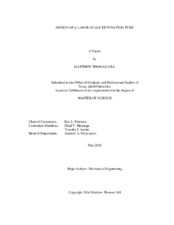| dc.description.abstract | Multiple vital industries, especially those in the energy sector, are vulnerable to unexpected detonation events. Extremely destructive and difficult to predict, the processes by which they are formed and the limits over which they can propagate have been a significant focus of research for years, but it is often difficult to carry out relevant experiments on any significant scale. This work presents the motivations for such study, the basic theory required to understand what is happening within a detonation, and the designs for a proposed facility which could be used to broaden the scope of current detonation research. It would allow the detonation phenomenon to be studied at a scale which is rarely achievable and with a precision which is rarely accomplished. This would help to either validate or disprove trends which have been established with small-scale rigs but not tested at the proposed size.
Most detonation tubes have diameters no larger than a 30 cm; the proposed facility boasts an internal diameter of 70 cm and a length of 100 m, allowing mixtures which are usually outside of the range of detonation to be studied in novel ways. Detonations can be induced through deflagration-to-detonation transition using a small point energy source, or directly initiated via a shock wave or the explosion of a separate, more energetic mixture. Measurement is accomplished with pressure transducers and photodiodes spaced down the length of the tube. End-tube diagnostics include fast-framing Schlieren imaging and Planar Laser-Induced Fluorescence, and use elongated windows to view the tube interior, allowing the reaction zone structure to be studied at large scale. Smaller windows spaced down the length of the tube enable additional data-gathering capabilities where necessary. The implementation of this facility would serve to increase the scope of understanding of detonation events and contribute to the improvement of safety standards for vulnerable workplaces. | en |


